Process Folder of Images Using Image Batch Processor App
This example shows how to use the Image Batch Processor app to process a batch of images in a folder or datastore.
Create a new folder in an area where you have write permission and copy a set of 10 images from the Image Processing Toolbox imdata folder into the new folder.
mkdir("cellprocessing"); copyfile(fullfile(matlabroot,"toolbox","images","imdata","AT3*.tif"),"cellprocessing","f");
Load Images into Image Batch Processor App
Open the Image Batch Processor app from the MATLAB® toolstrip. On the Apps tab, in the Image Processing and Computer Vision section, click Image Batch Processor ![]() .
.

Load images into the app. In the app toolstrip, click ![]() above Add. In the Load Images from Folder dialog box, specify the folder containing the images you want to load. For this example, specify the folder that you created in the first step,
above Add. In the Load Images from Folder dialog box, specify the folder containing the images you want to load. For this example, specify the folder that you created in the first step, cellprocessing. By default, the app includes images in subfolders. Then, click Load.
To load images from a folder, including subfolders, in the app toolstrip, under Add, select Folder, include subfolders. To load images from an imageDatastore object in the MATLAB workspace, under Add, select Image datastore from workspace.
The Image Batch Processor app creates thumbnails of the images in the folder and displays them in a scrollable tab in the left pane. The app displays the first selected image (highlighted in blue) at a greater resolution in the Input Image tab in the right pane.
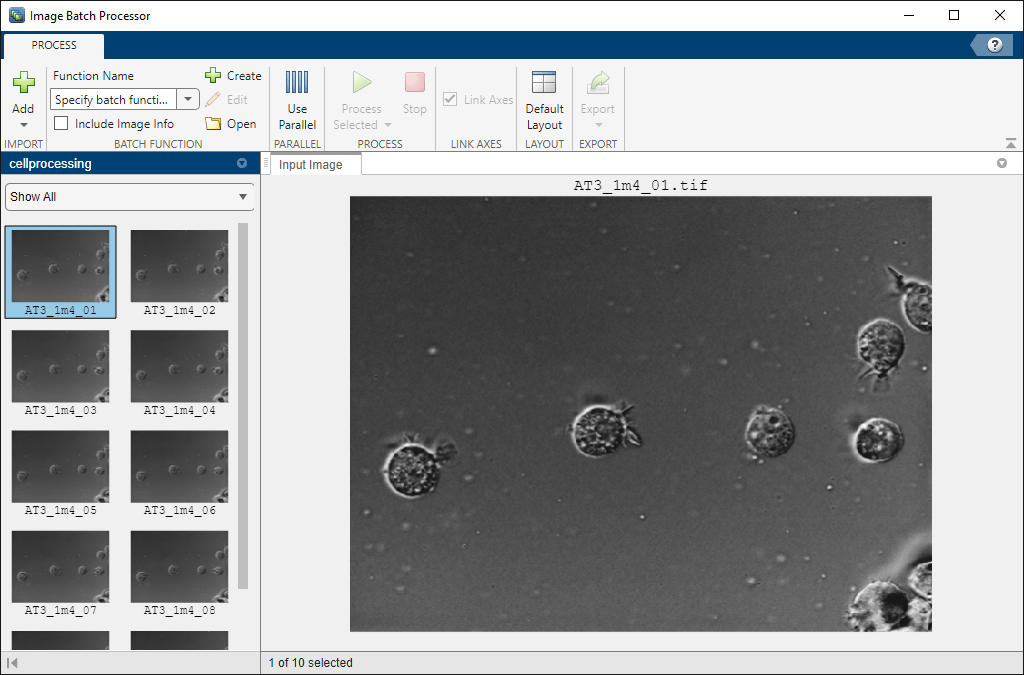
Specify Batch Processing Function
Specify the name of the function you want to use to process the images in the folder. To specify an existing function, type the name in the Function Name box in the Batch Function section of the app toolstrip. The function can be a MATLAB function, such as imbinarize, or a previously created custom batch function. If you use a MATLAB function, it must have the signature out = fcn(in). You can also click the folder icon next to the box to browse and select the function. To create a new batch processing function, click Create in the Batch Function section of the app toolstrip. When you do this, the app opens the batch processing function template in the MATLAB Editor. For this example, click Create to create a new function.
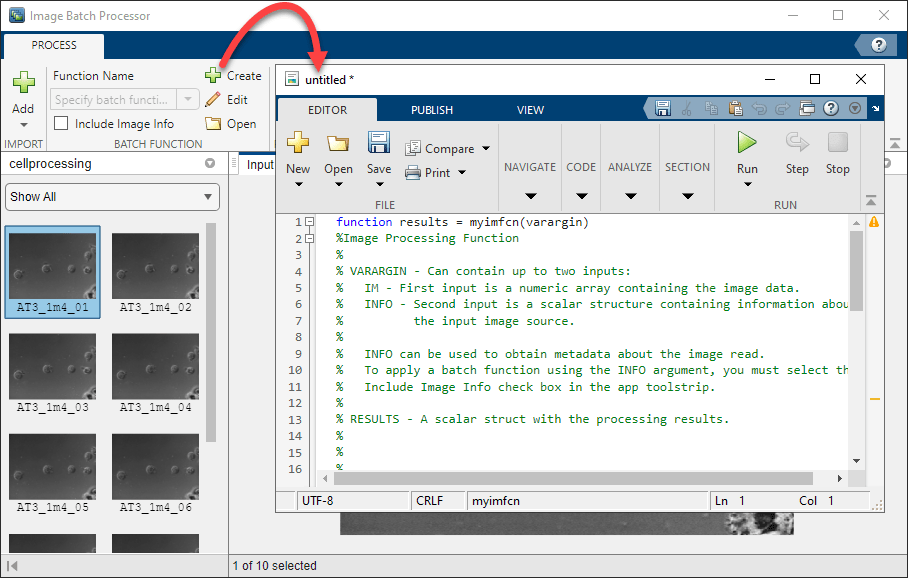
In the batch processing function template, enter code for the new function into the space reserved in the template file and click Save. This example uses the default name for the batch processing function, myimfcn, but you can specify any name. For this example, the code specifies a function that creates a mask image, calculates the total number of cells in the image, and creates a thresholded version of the original image.
function results = myimfcn(varargin) %Image Processing Function % % VARARGIN - Can contain up to two inputs: % IM - First input is a numeric array containing the image data. % INFO - Second input is a scalar structure containing information about % the input image source. % % INFO can be used to obtain metadata about the image read. % To apply a batch function using the INFO argument, you must select the % Include Image Info check box in the app toolstrip. % % RESULTS - A scalar struct with the processing results. % % % %-------------------------------------------------------------------------- % Auto-generated by imageBatchProcessor App. % % When used by the App, this function will be called for each input image % file automatically. % %-------------------------------------------------------------------------- % Input parsing------------------------------------------------------------ im = varargin{1}; if nargin == 2 % Obtain information about the input image source info = varargin{2}; end % Replace the sample below with your code---------------------------------- imstd = stdfilt(im,ones(27)); bw = imstd>30; thresholdMask = imfuse(im, bw); [~, n] = bwlabel(bw); results.bw = bw; results.thresholdMask = thresholdMask; results.numCells = n; %-------------------------------------------------------------------------- end
Save the file. After saving, the app displays the name of this new function in the Function Name box on the app toolstrip.
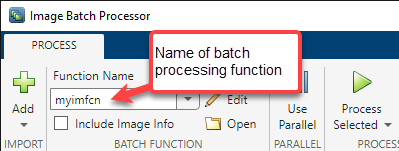
Process Images Using Batch Processing Function
Test the new function by running the batch processor on one of your images. With one image selected (highlighted in blue), click Process Selected to process the selected image. The app displays the results of the processing in a new panel called Results. For this example, the app displays the binary mask, a count of the number of objects (cells) in the image, and a thresholded version of the image.
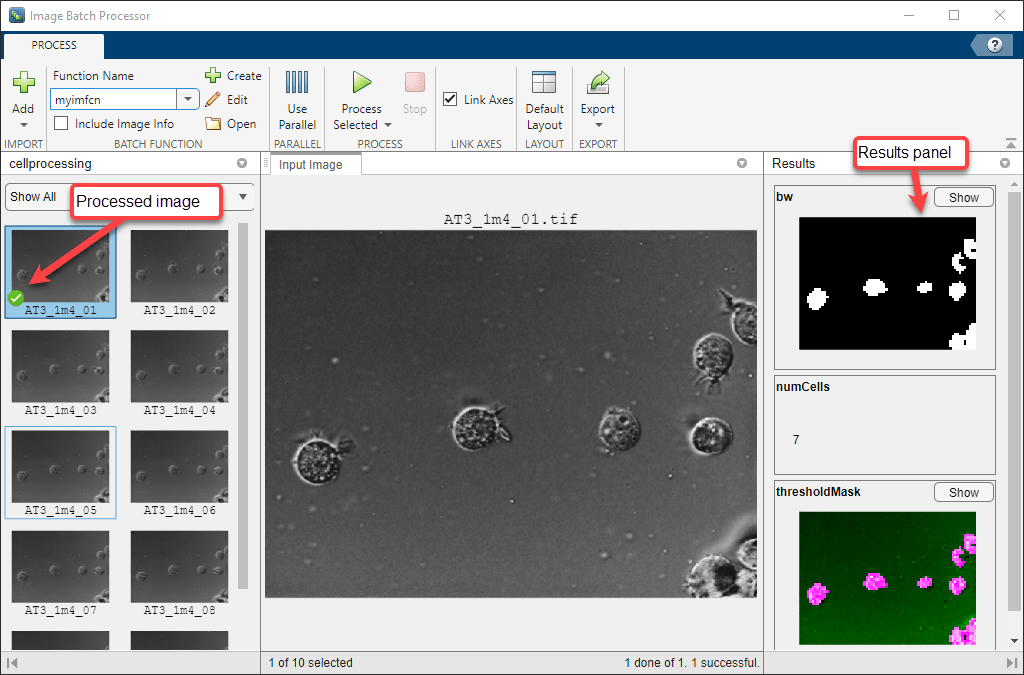
To get a closer view of the image results, click Show for that particular result in the Results panel. The app opens a larger resolution version of the image in a new tab in a bottom-center pane. For this example, view the binary mask results be clicking Show for bw in the Results panel. To explore the results, move the cursor over the image to access the pan and zoom controls. When zooming and panning, the app links the result image to the original image—panning or zooming on one image causes the other image to move as well. If you do not want this behavior, clear Link Axes in the app toolstrip.

If the results of the test run on one image are successful, then execute the function on all of the images in the folder. To process all the images at once, on the app toolstrip, click Process Selected and select Process All. To process only a subset of the images, click Process Selected. You can select images to process either by pressing Ctrl and clicking the desired images or by clicking one image to start, pressing Shift, and clicking another image to select all images in between the starting and ending images. If you have Parallel Computing Toolbox™, you can click Use Parallel on the app toolstrip to process the images on a local parallel pool. For this example, process all of the images.
The app processes all the images in the folder or datastore. A filled-in green square next to a thumbnail indicates the app successfully processed that image. The Results panel contains the results of the selected image (highlighted in blue). A status bar at the bottom-right of the app reports on the number of images processed.
Export Processed Images and Processing Pipeline
To save the results, click Export to view the options available. You can export results to the workspace or to a file, or you can get the MATLAB code the app used to generate the results.
Save the results in a workspace variable. On the app toolstrip, click Export and select Export result of all processed images to workspace option. In the dialog box that opens, select the results you want to export. A common approach is to export the nonimage results to the workspace and save the images that result from the processing in files. This example saves the cell count along with the name of the input file to the workspace variable numCells.
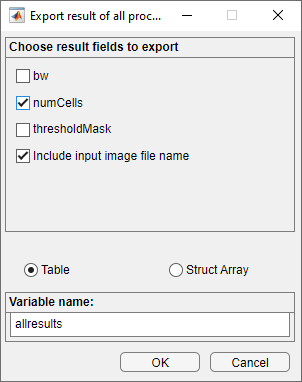
By default, the app returns the results you select in a table named allresults. To store the results in a structure instead of a table, select Struct Array in the dialog box. To specify another name for the result variable, change Variable name in the dialog box. If you select Include input image file name, the app includes the name of the image associated with the results in the structure or table. After specifying exporting details, click OK.
To get the MATLAB code that the app used to process your files, on the app toolstrip, click Export and select Generate function. The app generates a function that accepts the input folder name or imageDatastore object, as well as the output folder name, as input arguments. By default, the generated function returns a table with the results, but you can choose a structure instead. For image results, you can specify the file format and whether you want the function to write the image to the specified output folder.
See Also
Image Batch Processor | imageDatastore